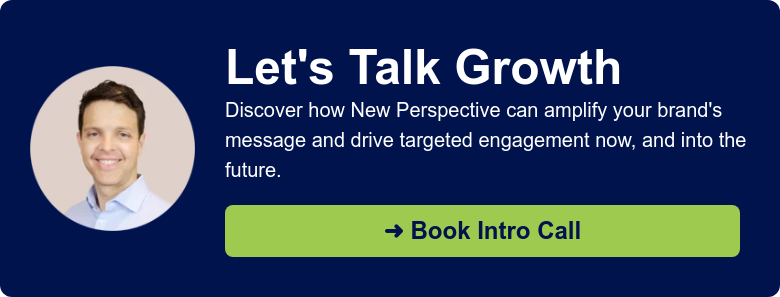What Happens During Our 60-Day Client Onboarding Process

At New Perspective we start strategic planning as soon as we start working with a client. In the first 60 days, that entails a deep dive into your business goals for the immediate, near-future and the long term.
It’s an intensive process of meetings and workshops to get aligned. We engage with all relevant parties on your side, striving to maximize the value our efforts bring to each and building transparency among all the stakeholders.
We find that some clients aren’t used to that level of involvement. But the investment in time and effort that’s well worth it, with end results have proven themselves out again and again.
Whether you’re interested in working with us or you’re looking for a roadmap of best practices, here’s an outline of what this process looks like here.
Setting the Foundation for Success: Kickoff and Onboarding Meetings
The first meetings include a detailed kickoff and client onboarding. Getting started is all about getting to know each other. We want to meet your team, understand your goals as a company, and start gaining alignment among everyone involved.
One thing we’ve found makes a huge difference in terms of success is asking a lot of questions. As our production manager Zach Etten pointed out recently,
“Be prepared to answer some hard questions — they will probably make you think differently about your business and target customers, and they may not be entirely comfortable. But we need everyone’s focus. It’s a collaborative effort, and thinking outside the box really helps us arrive at a truly strategic plan.”
We also want you to get to know how we’ll be working. So we walk you through our toolstack, and set expectations for how we will communicate and work through dependencies and track progress as a team.
To manage projects and communicate, we use Basecamp. We share meeting recaps on the message board, track project to-do’s, and assign tasks to appropriate team members.
To collaborate, we use Google Docs. Deliverables will be shared as working documents in the Google Drive for external review, input, and approval.
For project management, we’ll also present you with a gantt chart of the upcoming plan for the engagement. We’ll also schedule out the strategy workshops.
To ensure that each member of your team can come prepared for those, we’ll offer you additional materials and questionnaires.
Head to our blog for some key tips on how to get prepared for a strategy workshop.
Understanding Your Audience: The First Step in Strategic Marketing
Who is your audience? That’s one of the core goals of our strategic approach. In this first phase we need to develop a comprehensive understanding of your target audience. Often it’s the first time our client has focused so closely on this as well.
Creating Customer Personas to Target Ideal Clients
Buyer personas are crafted, detailed representations of ideal customers, including their common traits, behaviors, needs and wants.. Once we craft them, we’ll use them to make sure our communication is targeted and relevant.
In the competitive realm of online marketing, resources are precious and the environment is saturated. Utilizing buyer personas to make messages more precise means they reach the right people at the right time, maximizing engagement and resource efficiency.
The Jobs-to-Be-Done Framework: Solving Real Customer Needs
Your target audience, like everyone else, has a specific job to do. They have their own sets of personal and professional goals and objectives. Once we have the target personas set, we start looking at them through the jobs-to-be-done framework.
It’s a brilliant way to define the real needs and goals of your target customer. The approach is about providing solutions to customers, not just products or services: as one famous example goes, a customer doesn’t want a quarter inch drill bit. They want a quarter inch hole. They don’t care about the bit. They care about the hole.
Understanding this concept allows us to position your solutions as cost-effective, highly valuable, and just what your customer needs. Learn more about the jobs-to-be-done framework in HubSpot’s free course here.
Establishing a Brand Identity: Voice, Tone, and Visual Consistency
Often our strategy process builds toward creating a strong, consistent brand presence across your company, and once that’s all established, we clarify that in a custom brand book.
It’s the culmination of getting to know you, your audience, and the solutions they’re after, and it defines your messaging, your voice and tone, and the look and feel of your visuals.
This phase tends to be extremely helpful for clients, and encouraging as well. It involves efficient and fun brainstorming sessions with our project, content, copywriting and design teams.
We make sure you, the client, are comfortable with the direction we’re taking every step of the way.
We bring our content, copywriting and design teams in for lively brainstorming sessions. For many of our clients, this is a truly collaborative phase with big payoffs.
Crafting Impactful, Authentic Brand Statements With The Messaging House Workshop
There’s so much to creating a message with real impact that we built an entire “house” for this part of the strategy process.
We bring clients into the Messaging House when it’s time to craft, personalize, and tailor the right messaging so it truly resonates with your target audience.
This is where we identify your core values, mission and services or products — and articulate it in simple statements.
We work on what should be excluded as much as included, since that’s key to being found by the right clients.
The goal isn’t perfectly polished copywriting — that will come next. It’s clarity, consistency, and authenticity.
This is a great chance to really look at your company, and our clients often gain a new understanding about their core values and mission.

Defining Your Brand’s Voice and Tone to Stand Out in a Competitive Market
Once we’re settled on the what, it’s time to focus on how it’s conveyed. A huge problem we solve for many of our clients is that their brand’s voice (the “sound”) and tone (the “mood”) is inconsistent across communications.
It’s a common occurrence with fast-growing firms who crafted messaging on the fly to meet urgent needs (like an upcoming trade show or a social media campaign).
But having a unique voice and tone is critical for standing out in a competitive and noisy market, and being real is just as important as being consistent. If you want to connect with customers, you need to achieve both.
We develop a set of guidelines for your brand’s voice and tone so whatever team is working has the same information, and whatever the channel, the voice and tone are the same.
That way no matter where you find your target audience (or more likely, they find you), you present the same identity as a brand.
The more customers can engage with your particular voice and tone, the stronger their connection to you as a potential solution. The right voice and tone will do wonders for brand perception.
How Consistent Branding Drives Recognition and Loyalty
Last but not least are the visual assets: the logo, color schemes, fonts, icons, graphics and images that represent your brand.
And it’s not just what they are, it’s how they’re used that matters. Again consistency is vital to building recognizability and trust — and that leads to brand loyalty.
It’s hard for an audience to have faith in a brand that keeps changing its image. We’ll work with the client to make sure the visual identity fits into your overall marketing strategy so you can establish that all-important consistency.
Creating the Brand Book
Once we have your voice, tone and visuals all established, we created a detailed brand book that documents all of it.
These are guidelines you’ll be able to use going forward, with plenty of information about how to deploy each element.
Our clients have told us they appreciate having all the rules spelled out — so they don’t have to constantly check with an outside source to know what to do. We also find that being confident is a big part of staying consistent.
When you don’t have to second-guess what color palette to use, or what type, the process is easier and faster. (And we know you’ve got enough on your plate already.)
Take a look at our blog that covers the 5 core elements to creating a brand book for the Cleantech industry.
Goal-Setting for Success: Applying the SMART Framework
We believe in setting goals that make sense, keep everyone engaged, and don’t waste anyone’s time. That’s why we use the SMART framework (yes — we love frameworks that really work).
SMART goal-setting is all about clarity, efficiency, and effectiveness:
- Specific: Define what you aim to achieve with precision.
- Measurable: Set quantifiable benchmarks to gauge your progress.
- Achievable: Ensure your goals are realistic, given your resources.
- Relevant: Align your goals with your overarching objectives.
- Time-bound: Assign a clear deadline for completion.
Generating a certain number of leads, boosting website traffic by a specific percentage, or increasing social media followers within a set timeframe are all examples of SMART goal-setting.
We use specific metrics and digital to make sure we’re hitting the mark.
Here are three real-life examples:
- Increase leads from online campaigns for a global client in the carbon capture and storage arena
- Deploy an efficient lead-tracking system for a wind energy technology firm
- Reduce the cost per lead by at least a third for a B2B tech company (we reduced it by 48+%)
Aligning Stakeholder Desires with Strategic Priorities and Wishlist
Here’s the reality: There’s an endless list of actions we could take and plans we could make, but you have a limited amount of time and a specific budget.
We’re strong advocates of thoughtful triage. Throughout the strategy planning process, we’ll consider what tactics and deliverables will deliver the most value out of the gate, and make them the priority.
But as your company’s own team gains insights into its own wants and needs, as the market changes or other developments come up, we want to know.
So we’ll conduct a wishlist workshop: a collaborative session where all team members or stakeholders (on the New Perspective side and yours) gather to discuss and prioritize desires, needs, and nice-to-haves to tackle the SMART goals we put in place.
This is a powerful opportunity to brainstorm and compile a comprehensive list of features, improvements, or objectives that you wish to see implemented.
It’s also a time to think big: If time and money were no object, what would you want to see put in place for your business?
The sky's the limit! Then we’ll take a step back and prioritize. We follow the 80/20 rule of prioritization: we focus on that 20% of collective activities that will drive 80% of the value for your business goals.
This process ensures that all voices are heard and that the most important and impactful ideas are identified and ranked according to priority, helping to guide decision-making and strategic planning moving forward. We’re there to help you succeed well beyond the first 60 days.
Ready to Partner with Us? Let’s Build a Strategic Roadmap Together
At New Perspective, we are not just consultants. We are active partners dedicated to navigating the path to success alongside you, with strategy leading the way.
Ready to get started? We would love to set up an initial meeting to talk with you about everything we can accomplish together.
You can also download our free Strategic Planning Kit to get a head start on preparation for success.




